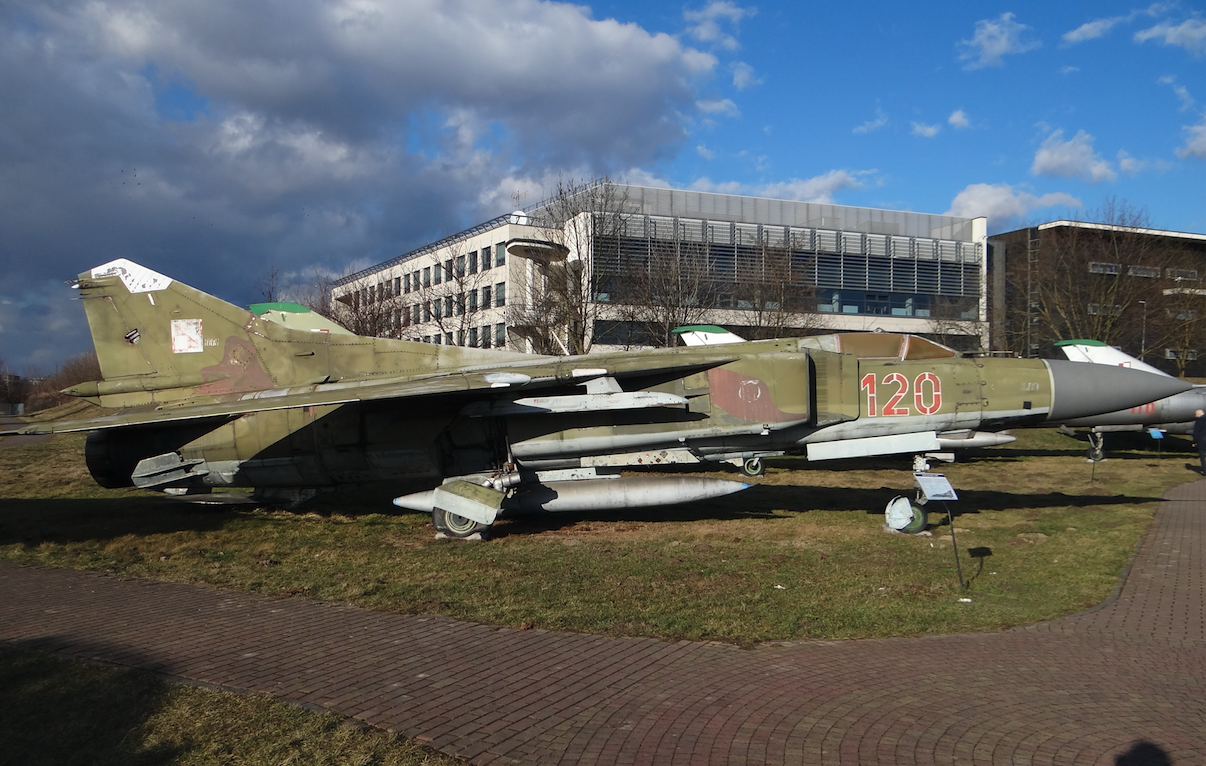Kraków 2007-01-02
255 Section 1979-06-04
OKB Mikoyan and Gurevich MiG-23 MF, UB. Poland
A fighter aircraft with variable wing geometry.
Construction
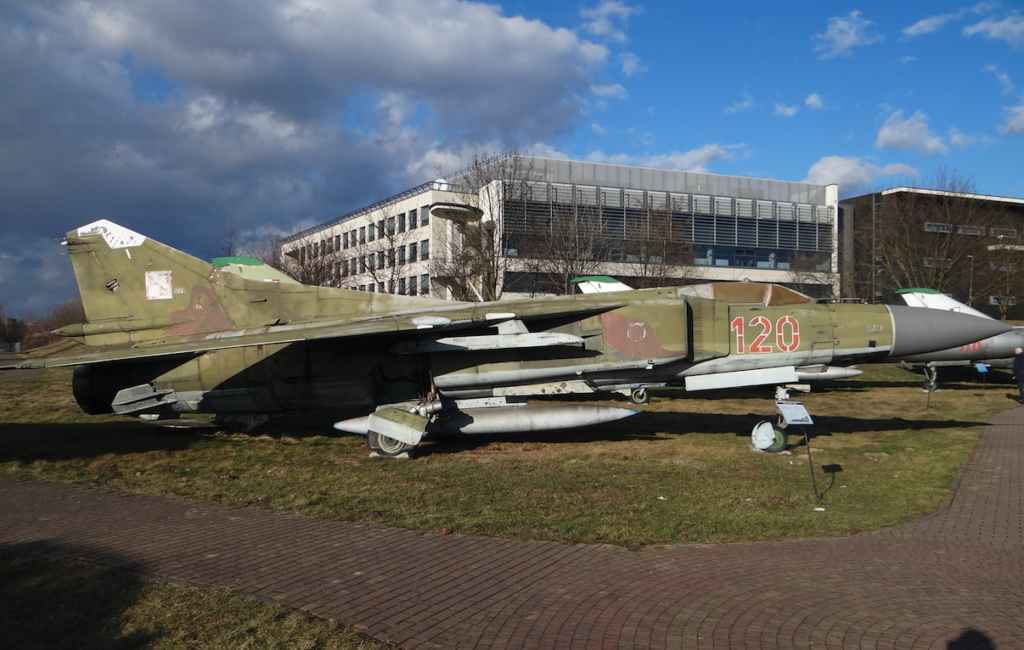
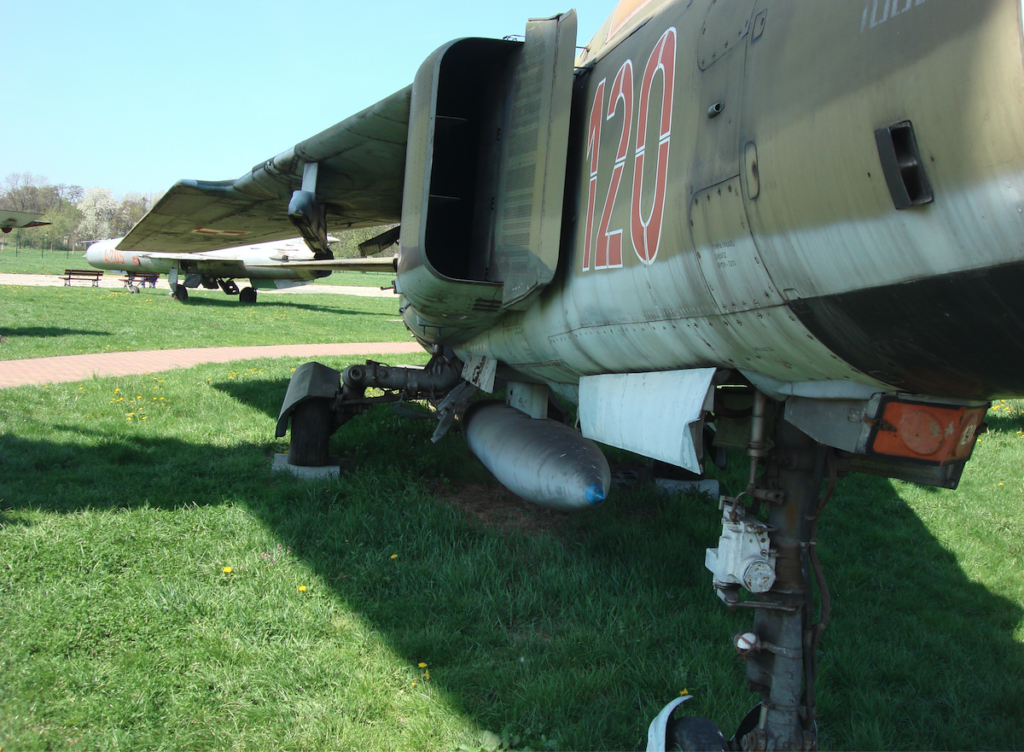
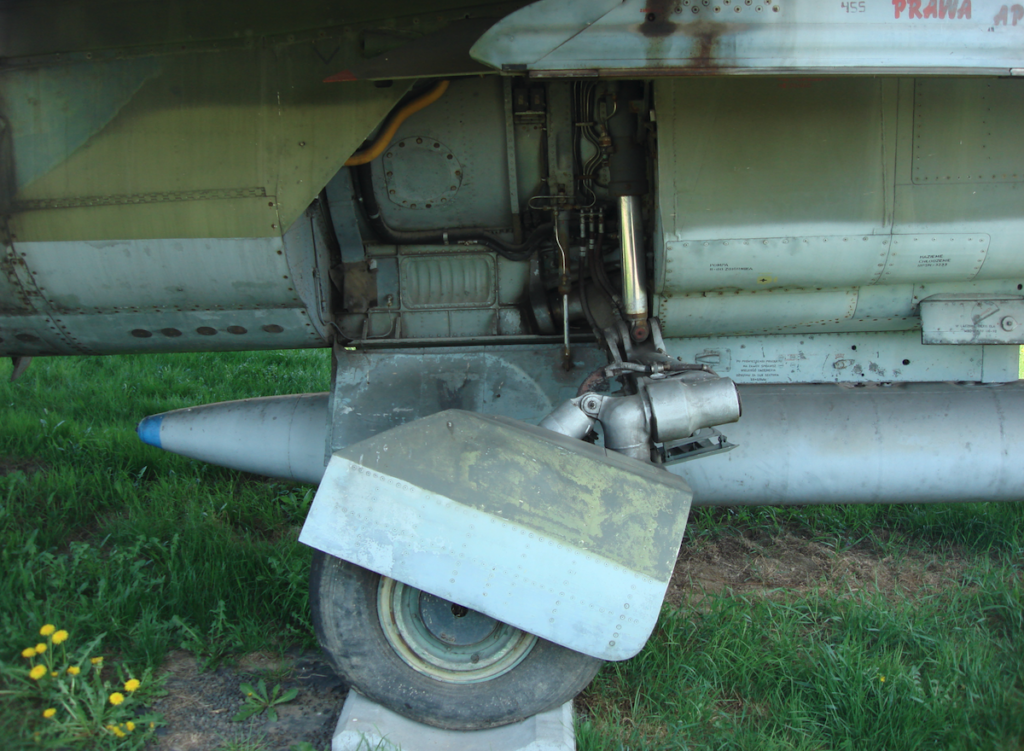
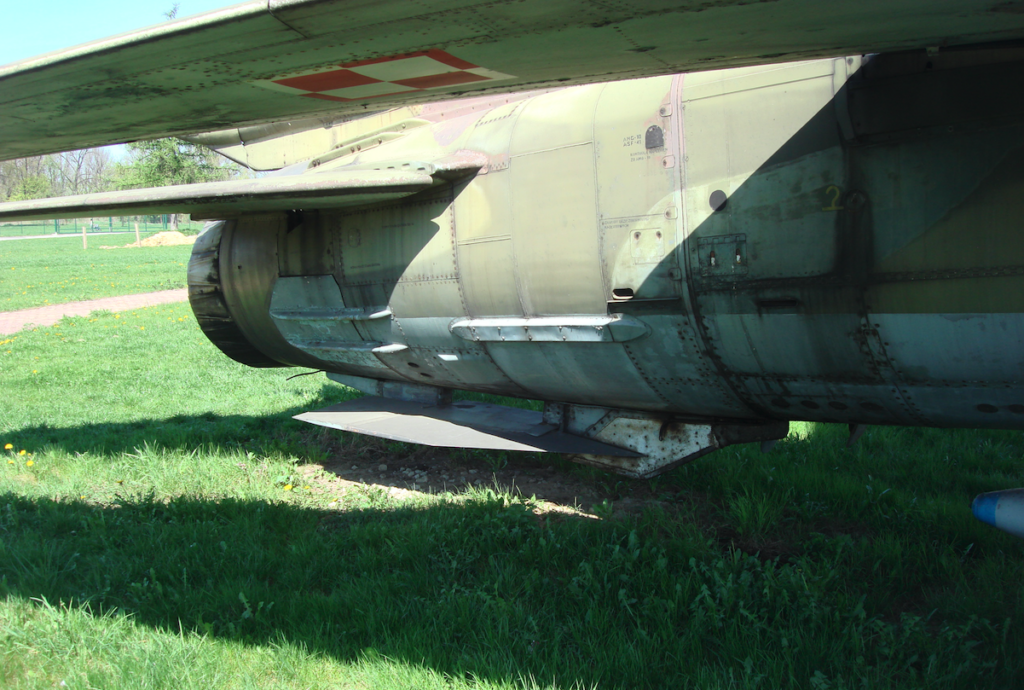
MiG-23 MF design
Single-seat, single-engine supersonic interceptor, also capable of performing attack and bombing missions. High-wing monoplane with variable wing geometry. Main strength elements made of steel; fuselage fuel tanks, wing spars and empennage, wing suspension nodes. In addition, aluminum alloys and, to a small extent, titanium alloys, magnesium and composites were used in the design. The aircraft withstands a load of 7g, and with a minimum wing sweep of 4.5g.
Wings
The wings consist of a center wing with a leading edge sweep of 70 degrees and moving parts with a sweep angle change in the range from 18 degrees 40 minutes to 74 degrees 40 minutes. The wedge angle is 0 degrees, and the lift is -4 degrees. The center wing contains integral fuel tanks of 2 x 90 liters, radio antennas, an oxygen tank, weapon nodes and a wing rotation mechanism. The rear part of the center wing contains a sealing system connecting the moving and fixed parts of the wings. It is made of hinged flaps and vertical curtains with Teflon seals, pressed rods, levers and pneumatic actuators. The moving parts are mounted on a large diameter pin. Movement is provided by a hydraulic system. Structurally, they have two spars and 7 ribs. The interior has fuel tanks with a capacity of 2 x 215, 2 x 140, 2 x 90 liters. The wings are equipped with 4-segment noses tilted by 20 degrees, with an area of 1.32 square meters. Their movement is synchronized with the rear flaps. On the upper surface, 2-segment spoilers are mounted, with an area of 0.6 square meters, tilted by 45 degrees at a small wing sweep angle. On the trailing edge, 3-segment flaps are mounted, with an area of 5.9 square meters, tilted by 25 degrees at takeoff and 50 degrees at landing. Each segment is supported on two bearings, with the end segments having friction vibration dampers.
The fuselage
The fuselage is technologically divided into two parts on frame no. 28. The front part is 60% occupied by fuel tanks. Frame no. 6 houses electronic equipment, mainly a radar station. A hermetic pilot’s cabin is placed between frames no. 6 and 12. The front landing gear with an actuator is attached to frames no. 6 and 11. The remaining equipment is placed from the pilot’s cabin, under it a lowerable gun carriage and two weapon mounting nodes. The side air intakes to the engine are moved about 90 mm away from the fuselage. The air intake plane is tilted forward by 3 degrees. The front air intake wedge is fixed. Behind it is a hinged plate with perforation for sucking out the boundary layer of air. A second plate is also movable with it, but with a hinge at the rear. Adjustment is performed by hydraulic actuators with a lever system. The plates are hermetized by vertical curtains and Teflon profiles at the top and bottom, pressed by flat springs. Two additional air intakes are placed on the air ducts. Frame No. 14 starts with fuel tank No. 1 with a capacity of 1,940 liters and ends with frame No. 18, which at the same time starts with tank No. 2 with a capacity of 870 liters and ends with frame No. 20. This is where the main power elements of the center wing, the main landing gear and the attachment node of the underwing tank are attached. Between frames No. 20 and 22, there are the main landing gear compartments closed with 4 flaps. Fuel tank No. 3, with a capacity of 740 liters, is closed by frame No. 28. The engine, another center wing fitting and armament nodes are attached to frame No. 25 with three hooks. The tail section starts with frame No. 28A. Between frames 29 and 30 there is a fuel tank no. 4 with a capacity of 470 liters. The tail, air brakes and afterburner pipe are attached to frame no. 31. Air brakes, upper with an area of 0.21 square meters, and lower with an area of 0.40 square meters. Swinging 45 degrees. Behind frame no. 32 the fuselage is made of titanium.
Tail
Horizontal plate tail with a leading edge sweep angle of 55 degrees and 40 minutes, with an area of 6.93 square meters. Deflected with longitudinal control by +8.5 degrees and -24.5 degrees, and with transverse control by -1 degree with the wing <57.40 degrees and 6.5 degrees >57.40 degrees. The tail has a mixed construction, classic, riveted at the front, honeycomb, glued at the rear. The horizontal tail has a span of 5.51 m. Vertical tail with a sweep of 72 degrees and 20 minutes, with an area including the inflow of 7.21 square meters. The rudder deflected by 25 degrees and an area of 0.93 square meters. The stabilizer is attached to frame no. 29B and 31. Classic construction, honeycomb, glued rudder. A parachute container is placed under the rudder. At the bottom, a foldable aerodynamic steering wheel with an area of 1.42 square meters. Folding is performed to the right by 90 degrees and is synchronized with the chassis.
Chassis
The chassis is moved hydraulically. Emergency extended by compressed air. Pneumatic disc brakes. Liquid-nitrogen shock absorbers. Front chassis type KT-152 with dimensions of 520 x 120 mm and a track of 250 mm, in a shot-down arrangement. Hydraulically controlled by the MRK-30 device with a deflection of 40 degrees. Mudguards. Main chassis KT-150 D with dimensions of 840 x 290 mm. Tubeless pneumatics. The chassis base is 5.812 m, track 2.86 m.
Ejection seat.
Ejection seat type KM-1M, weighing 135 kg, class 0-130. Limitations are maximum speed up to 1,200 km/h and ceiling 20,000 m. In the first phase, the seat ejects a pyrocartridge, and after moving 0.82 m, the rocket engine starts operating for 0.38 seconds and ejects the seat about 45 m from the aircraft’s flight path. Then a stabilizing parachute with an area of 0.1 m2 opens. Then, depending on the ceiling, a second one with an area of 2 m2. At an altitude of less than 3,000 m, the main parachute with an area of 54 m2 opens. Descent < 6 m/s. When ejected at an altitude of 0 m, the main parachute opens at an altitude of > 25 m. The seat is controlled by the KAP-4/425 device. At the seat there is an emergency pod NAZ-7 in a sea, desert or northern variant. It contains food, signaling, communication means, a first aid kit, a boat MŁAS-1 (Polish LŁR), field equipment.
Cabin equipment.
Above the instrument panel there is a head-up display of the SEI system showing navigation data and aiming parameters. On the left side of the panel from the top; UUA-1 angle of attack indicator, AM-10 K overload indicator, US-1600 K instrument airspeed indicator, WDI-30 K barometric altimeter, USM-1 K true airspeed and Mach number indicator, KPP pilot indicator (performs the functions of an artificial horizon and indicates the deviation from the prescribed flight trajectory), NPP navigation device (indicates the course, beacon angles, position relative to the glide path and others), DA-200 device (doubles the artificial horizon, is a variometer, inclinometer and turn indicator), clock. On the right there is; UPK-1 M wedge position indicator, ISK-1 wing position indicator, ITE-2 tachometer, ITG-1 turbine temperature, RTST-50 B fuel consumption, RW-4 radio altimeter. In the center are; arming switch, voltmeter, pressure gauge set. On the starboard side; on-board equipment switches. On the port side; wing sweep lever, flap control button, landing gear retraction and extension, radio station operation.
Engine
Two-flow, turbojet R-29-300 isodienie 55, with 1 x 81.40 kN thrust, and 1 x 120.0 kN with afterburner. Engine length 4,991 mm, diameter at compressor height 846 mm, and at combustion chamber height 922 mm. Maximum gas temperature behind the turbine is 1,000 degrees Celsius. Engine weight 1,222 kg. It consists of; 5-stage low pressure, (1st and 2nd stage made of titanium, the rest of them made of heat-resistant steel), 6-stage high pressure, with a compression ratio of 13:1, annular combustion chamber with 18 injectors, 1-high pressure turbine, 1-low pressure turbine, afterburner about 1.5 m long with three rows of injectors. The engine ends with an adjustable nozzle made of 18 flaps moved hydraulically. Starting the engine on the ground with a TS-21 turbo starter.
Fuel kerosene T-1, TS-1, RT. IPM-10 oil or synthetic WNII-50. Specific fuel consumption 0.9 – 1.2 kg/daN/h, with afterburning 1.5 – 2.0 kg/daN/h. Engine service life is 900 – 1500 hours depending on the production series. Time between overhauls 350 – 450 hours.
Installations
Fuel – also acts as a balancer for the aircraft and a coolant for some devices. In the basic version, the aircraft takes 4,800 liters of fuel. Additional tanks of 3 x 800 liters can be suspended. Pressure or gravity refueling.
Electric – 28 V DC, 208, 115 and 36 V AC and a frequency of 400 Hz single- and three-phase. Generators, battery pack. Two taxi and landing lights, position lights.
Pneumatic – two circuits, main and emergency. Brakes the wheels, seals the wing-fuselage transition, ventilates the equipment compartment, ventilates and seals the cabin, deploys and discards the braking parachute, emergency switches off some systems. Emergency deploys the landing gear in an emergency and retracts the under-fuselage steering wheel.
Hydraulic – two independent circuits, main and auxiliary. Retracts and extends the landing gear including the underbody steering wheel, controls the nose landing gear, air intakes, control surfaces, and sets in motion two wing rotation hydromotors.
MiG-23 MF equipment
Communication system – 120-channel R-832 M radio station in VHF and UHF bands, R-855 UM emergency radio station, SMU-7 system for pilot-technician communication.
Navigation and landing system – the system allows for flight along a programmed route and automatic approach to landing, RSBN-6 S close navigation system, RW-4 low altitude radio altimeter with a range from 0 m to 1,500 m, ARK-15 M automatic compass, MRP-56 M marker receiver.
Reconnaissance and warning system – SRZO-2 active interrogation and response system, SPO-10 radiation warning system (shows the direction and moment of interception by the enemy, SO-69 active response system.
Weapons control – Szafir s-23 radar station with AWM-23 analogue calculator, ASP-23 D optical sight, TP-23-1 thermal direction finder. The situation is visualised on the SIE display (sistiema jadinoj indikacji). It searches for targets, prepares data for the k.p.r., calculates corrections for the gun and e.g.r., highlights targets.
MiG-23 MF armament
The aircraft is equipped with 5 suspension nodes. 3 under the fuselage and 2 under the fixed parts of the wings. The middle node is used only to suspend the fuel tank. In the 90s, Polish aircraft were equipped with movable nodes under the movable parts of the wings, in the number of 2 pieces. They are used only to suspend fuel tanks or containers from e.g.p.r.
A double-barrel Nudelman-Richter GSz-23 Ł cannon, 23 mm caliber, 200 rounds.
class p-p k.p.r., 2 pieces each; R-3 S, R-3 R, R-13 M, R-55 on APU-68 E launchers; 4-6 pieces; R-60 M, R-60 MK on APU-60 IM or twin IIM launchers, R-23 R, R-23 T on APU-23 M launchers. p-z class, 2 pieces each; H-23 M on APU-13 MT launchers, H-23 M on APU-68 E launchers.
e.g. S-5-M 1, -K 1, -MO, -KO, -P, -S, -O, -I, KPM, in UB-32A or UB-16 containers and S-24 B weighing 235 kg on APU-68 E launchers.
Bombs weighing up to 500 kg. E.g. 16 x OFAB-100, 6 x FAB-250, 4 x FAB-500. Ignition tanks 2 x ZB-500. All on beams BD 3-60-23 F 1-Ł 1, MD 2-67 U or others.
MiG-23 MF T-T data:
Span from 7.779 m to 13.965 m. Length 17.18 m. Height 4.82 m. Wing area from 34.16 m2 to 37.27 m2. Empty weight 10,845 kg. Gross weight 15,750 kg. Maximum weight 18,270 kg. Landing weight 12,000 kg. Armament weight 4,000 kg. Fuel weight 4,800 liters + 3 x 800 liters. Maximum speed 2,445 km/h at 12,500 m. Maximum speed Ma-2.35. Maximum speed 1,350 km/h at 0 m. Climb 7 min to 15,000 m. Cruising speed 940 km/h. Landing speed 255 km/h. Maximum range 2,500 km. Operational ceiling 17,500 m. Takeoff run 580 – 825 m. Landing run 1,225 m.
Written by Karol Placha Hetman

